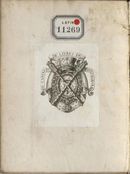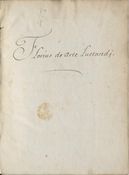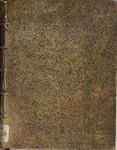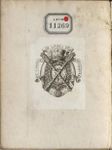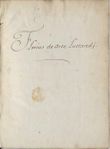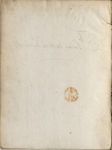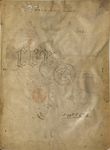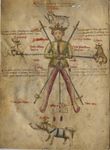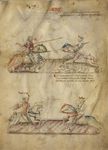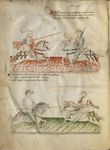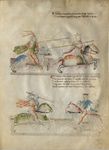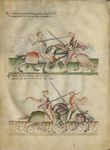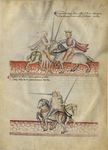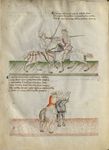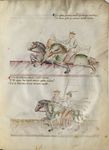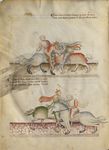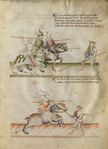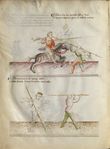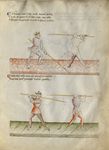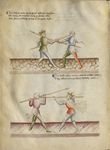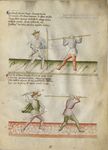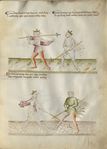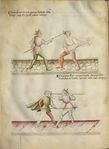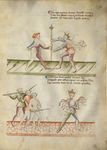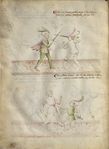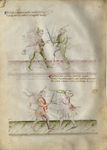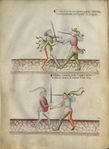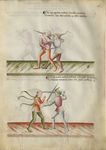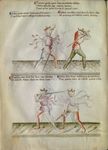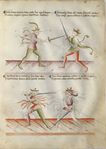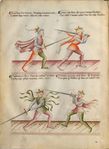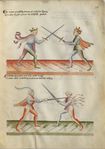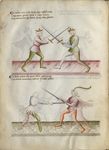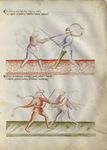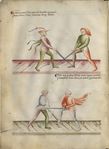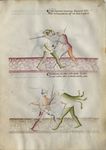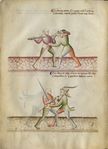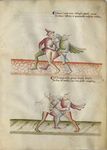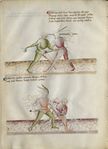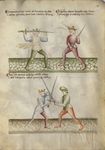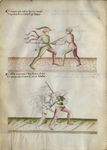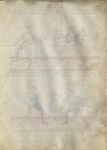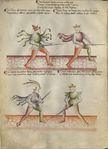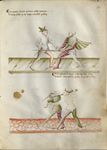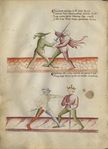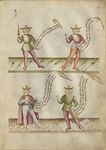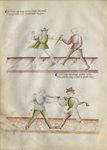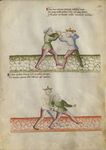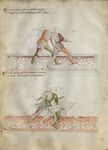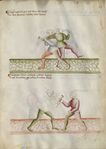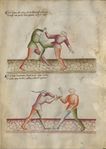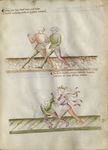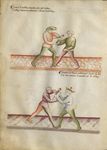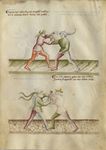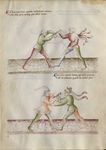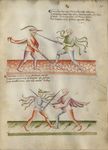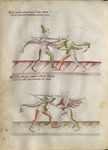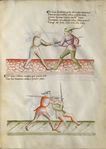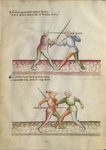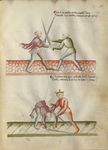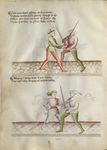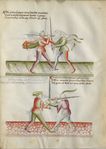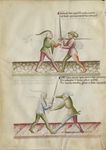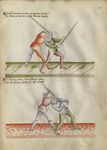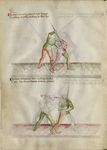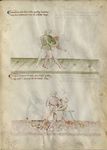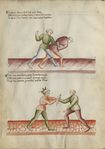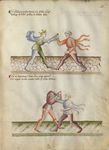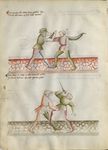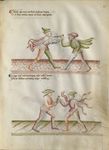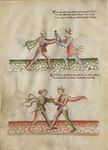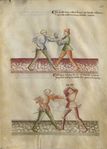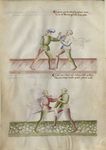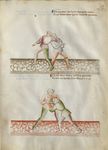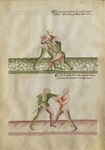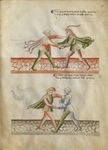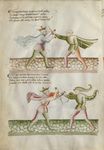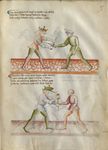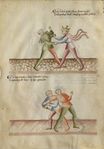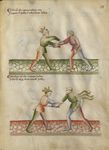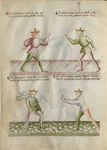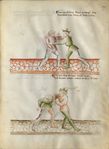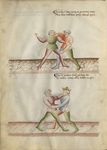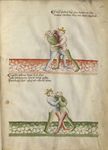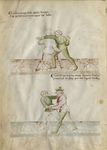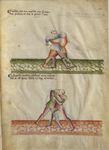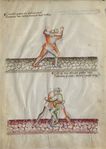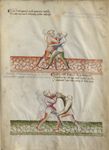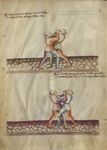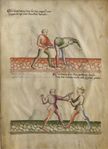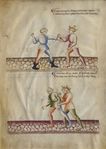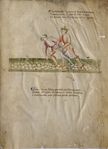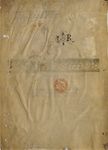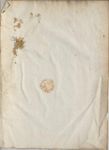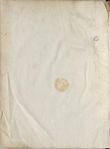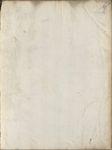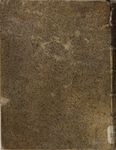|
|
You are not currently logged in. Are you accessing the unsecure (http) portal? Click here to switch to the secure portal. |
Florius de Arte Luctandi (MS Latin 11269)
| Florius de Arte Luctandi | |||||
|---|---|---|---|---|---|
| MS Latin 11269, Bibliothèque nationale de France Paris, France | |||||
| |||||
| |||||
| Type | |||||
| Date | ca. 1410s or 20s | ||||
| Language(s) | Renaissance Latin | ||||
| Author(s) | Fiore de'i Liberi | ||||
| Translator | Unknown | ||||
| Scribe(s) | Unknown | ||||
| Illustrator(s) | Unknown | ||||
| Material | Parchment, with a pasteboard leather cover | ||||
| Size | 44 folia (195 mm × 255 mm) | ||||
| Format | Double-sided; two illustrations per side, with text above | ||||
| Script | Semigothic | ||||
| Identified |
| ||||
| External data | Library catalog entry | ||||
| Treatise scans |
| ||||
Florius de Arte Luctandi ("The Flower of Battle", MS Latin 11269) is an Italian fencing manual translated from a treatise authored by Fiore de'i Liberi and probably created in the 1410s or 20s.[1] The original currently rests in the holdings of the Bibliothèque nationale de France in Paris, France. MS Latin 11269 is written in a semigothic script on parchment in a pasteboard leather binding; the illustrations are inked and painted, with gold leafing on the crowns and garters. This manuscript is generally referred to as either the Florius or the Paris.
Any preface MS Latin 11269 once possessed is missing from the current form of the manuscript, and its current title was added much later in a 17th century hand. It consists of 44 folios with two pairings per page, and is the only copy of Fiore's treatise whose illustrations are fully painted. Unlike the other versions of his work, this manuscript is written entirely in Latin.
Determining the derivation of this manuscript is difficult. Its descriptions are cast in couplets and quatrains that closely resemble those of the Pisani Dossi version, though often in a jumbled and semi-coherent fashion. The sequence is comparable to that of the Morgan version, beginning with mounted fighting and ending with wrestling on foot. The illustrations, though painted, often resemble those of the Getty version. Finally, in terms of content it contains plays otherwise unique to each of the other three manuscripts.
Contents
Provenance
The known provenance of the MS Latin 11269 is:[2]
- Written in the early 15th century, probably after the completion of Flos Duellatorum in 1409.
- 1467 - Possibly the Ms. 75 in the catalog of the Biblioteca Estense, in which case the description at the time was "Book on fighting called Florius friuiolen, teaching the form of fencing actions in the duel, cursive lettering, small format, illustrated in many ways on many different pages with letters above the figures, with a white eagle and two crests depicted over the first page, covered in white sheepskin with bosses and one clasp. The number of pages written and unwritten are 58".[3]
- ca. 1635 – rebound by a master papermaker who worked at the Puy-moyen mill for Sieur Janssen.
- before 1712 – in the Pontchartrain library, owned by Louis Phélypeaux de Pontchartrain (1643-1727). Donated to the Bibliothèque du Roi, where it was labeled Florius de Art Luctandi.
- 1712-present – held by the Bibliothèque du Roi/Bibliothèque nationale de France.
Contents
| 1v | The Seven Swords by Fiore de'i Liberi |
|---|---|
| 2r - 5v | Mounted fencing by Fiore de'i Liberi |
| 6r - 6v | Spear vs. cavalry by Fiore de'i Liberi |
| 6v - 8v | Spear by Fiore de'i Liberi |
| 8v - 10r | Axe in armor by Fiore de'i Liberi |
| 10r - 12r | Sword in one hand by Fiore de'i Liberi |
| 12v - 15v, 26r - 30v |
Sword in two hands by Fiore de'i Liberi |
| 16r - 19v | Sword in armor by Fiore de'i Liberi |
| 20r - 20v | Sword vs. dagger by Fiore de'i Liberi |
| 21r - 25v, 31r - 38r, 43r - 44r |
Dagger by Fiore de'i Liberi |
| 38v - 42v | Grappling by Fiore de'i Liberi |
| 44r | Closing |
Gallery
Additional Resources
- Lodà, Francesco (in Italian). Florius. De arte luctandi. Traduzione e cura del testo di Francesco Lodà. Rome: Bonanno Editore, 2014. ISBN 978-88-96950-86-9
- Marsden, Richard. The Flower of Battle: MS Latin 11269. Trans. Benjamin Winnick. Tyrant Industries, 2019. ISBN 978-0-9847716-3-9
- Mondschein, Ken. "Notes on Bibliothèque Nationale MS Lat. 11269, Florius de Arte Luctandi". Arms & Armour 8(2):117-22. October 2011. doi:10.1179/174962611X13097916223163
- Mondschein, Ken. "On the Art of Fighting: A Humanist Translation of Fiore dei Liberi’s Flower of Battle Owned by Leonello D’Este". Acta Periodica Duellatorum 6(1): 99-135. 2018. doi:10.2478/apd-2018-0004
- Mondschein, Ken and Greg Mele. Flowers of Battle, Volume 3: Florius de Arte Luctandi. Wheaton, IL: Freelance Academy Press, 2018. ISBN 978-1-937439-19-4
- Палій, Людмила Іванівна (in Ukrainian). "Витоки художнього стилю ілюстрацій «Квітки Битви» майстра Фіоре Фріулано деі Лібері". Науковий вісник Ужгородського університету 2(43): 84-102, 2020. doi:10.24144/2523-4498.2(43).2020.217366
References
- ↑ Based on dating the art and costume, and the apparent statement on folio 44r that Fiore was still alive when it was completed.
- ↑ Easton, Matt. Fiore dei Liberi - Fior di Battaglia - Flos Duellatorum. Schola Gladiatoria. Retrieved 30 October 2010.
- ↑ Liber Bellicosus verat. Florius friuiolen. docens for. Actorum dimicandi in duello Litteris cursivis in membranis forma parva figuratus diversis modis in plurimis et diversis cartis cum litteris super figuris cum Aquilla alba et duobus cimerijs pictis super prima carta Cohopert. montanina alba cum Brochis et uno azullo. Cart. inter scriptas et non scriptas. 58. Quoted from Giulio Bertoni. La Biblioteca Estense e la coltura ferrarese ai tempi del Duca I (1471-1505). Loescher, 1903.
Copyright and License Summary
For further information, including transcription and translation notes, see the discussion page.
| Work | Author(s) | Source | License |
|---|---|---|---|
| Images | Bibliothèque nationale de France | Gallica | |
| Transcription | Kendra Brown and Rebecca Garber | Index:Florius de Arte Luctandi (MS Latin 11269) |

